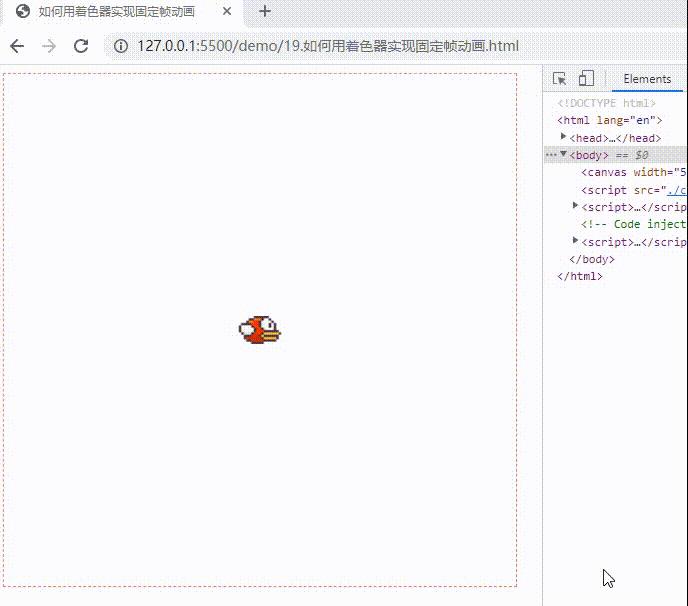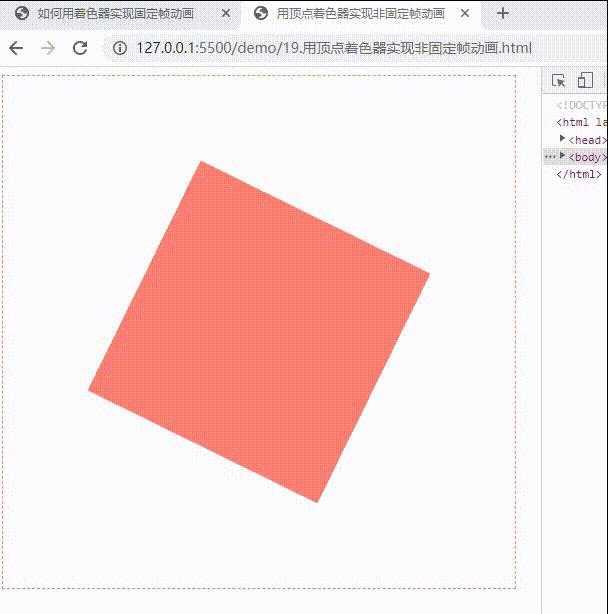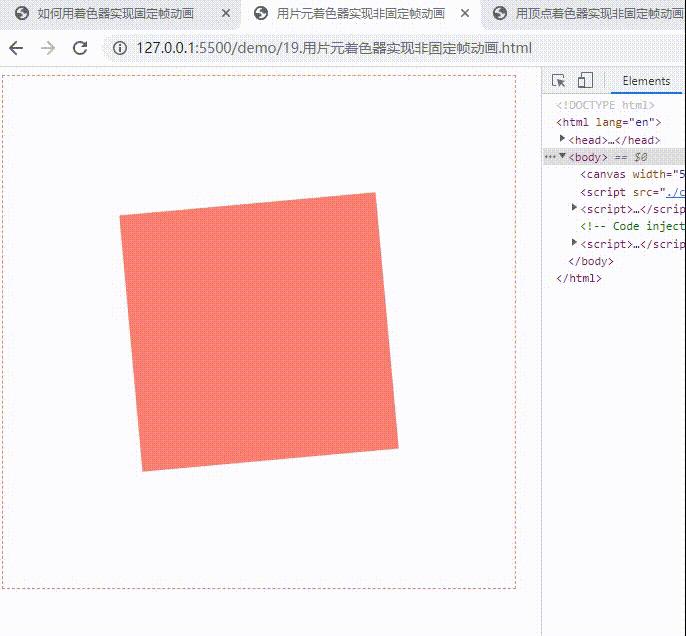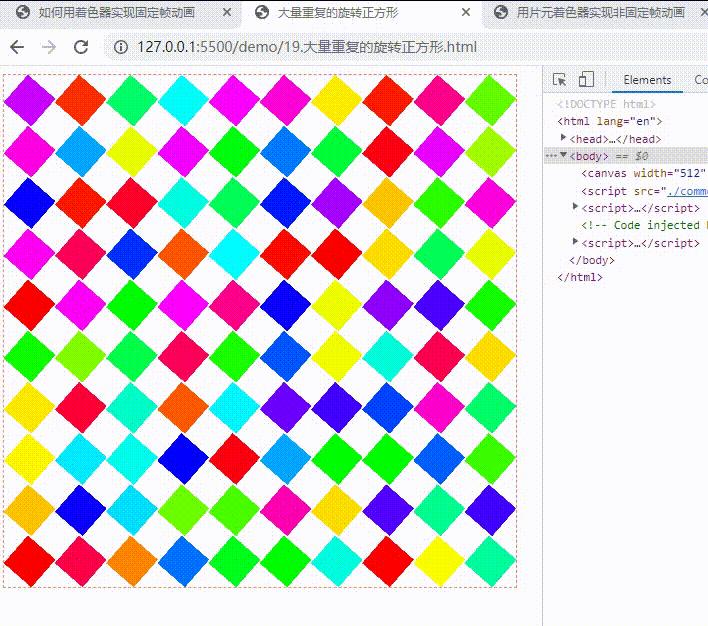视觉高级篇19 # 如何用着色器实现像素动画?
Posted 凯小默
tags:
篇首语:本文由小常识网(cha138.com)小编为大家整理,主要介绍了视觉高级篇19 # 如何用着色器实现像素动画?相关的知识,希望对你有一定的参考价值。
说明
【跟月影学可视化】学习笔记。
如何用着色器实现固定帧动画
<!DOCTYPE html>
<html lang="en">
<head>
<meta charset="UTF-8" />
<meta name="viewport" content="width=device-width, initial-scale=1.0" />
<title>如何用着色器实现固定帧动画</title>
<style>
canvas
border: 1px dashed salmon;
</style>
</head>
<body>
<canvas width="512" height="512"></canvas>
<script src="./common/lib/gl-renderer.js"></script>
<script>
const vertex = `
attribute vec2 a_vertexPosition;
attribute vec2 uv;
varying vec2 vUv;
void main()
gl_PointSize = 1.0;
vUv = uv;
gl_Position = vec4(a_vertexPosition, 1, 1);
`;
const fragment = `
#ifdef GL_ES
precision highp float;
#endif
varying vec2 vUv;
uniform sampler2D tMap;
uniform float fWidth;
uniform vec2 vFrames[3];
uniform int frameIndex;
void main()
vec2 uv = vUv;
// 动画只有 3 帧,所以最多只需要循环 3 次。
for (int i = 0; i < 3; i++)
// vFrames 是每一帧动画的图片起始 x 和结束 x 坐标
uv.x = mix(vFrames[i].x, vFrames[i].y, vUv.x) / fWidth;
if(float(i) == mod(float(frameIndex), 3.0)) break;
vec4 color = texture2D(tMap, uv);
gl_FragColor = color;
`;
const canvas = document.querySelector("canvas");
const renderer = new GlRenderer(canvas);
const textureURL = "./assets/img/bird.png";
(async function ()
const texture = await renderer.loadTexture(textureURL);
const program = renderer.compileSync(fragment, vertex);
renderer.useProgram(program);
renderer.uniforms.tMap = texture;
renderer.uniforms.fWidth = 272; // 图片的总宽度
renderer.uniforms.vFrames = [2, 88, 90, 176, 178, 264];
renderer.uniforms.frameIndex = 0;
setInterval(() =>
renderer.uniforms.frameIndex++;
, 200);
const x = 43 / canvas.width;
const y = 30 / canvas.height;
renderer.setMeshData([
positions: [
[-x, -y],
[-x, y],
[x, y],
[x, -y],
],
attributes:
uv: [
[0, 0],
[0, 1],
[1, 1],
[1, 0],
],
,
cells: [
[0, 1, 2],
[2, 0, 3],
],
,
]);
renderer.render();
)();
</script>
</body>
</html>

如何用着色器实现非固定帧动画
WebGL 有两种 Shader,分别是顶点着色器和片元着色器,它们都可以用来实现动画。在绘制一帧画面的时候,顶点着色器的运算量会大大少于片元着色器,所以使用顶点着色器消耗的性能更少。片元着色器可以使用重复、随机、噪声等技巧来绘制更加复杂的效果。
用顶点着色器实现非固定帧动画
在顶点着色器中,我们直接改变了顶点坐标,所以这样实现的旋转动画和 WebGL 坐标系(右手系)的方向一致,角度增大呈逆时针方向旋转。
<!DOCTYPE html>
<html lang="en">
<head>
<meta charset="UTF-8" />
<meta name="viewport" content="width=device-width, initial-scale=1.0" />
<title>用顶点着色器实现非固定帧动画</title>
<style>
canvas
border: 1px dashed salmon;
</style>
</head>
<body>
<canvas width="512" height="512"></canvas>
<script src="./common/lib/gl-renderer.js"></script>
<script>
const vertex = `
attribute vec2 a_vertexPosition;
attribute vec2 uv;
varying vec2 vUv;
uniform float rotation;
void main()
gl_PointSize = 1.0;
vUv = uv;
float c = cos(rotation);
float s = sin(rotation);
mat3 transformMatrix = mat3(
c, s, 0,
-s, c, 0,
0, 0, 1
);
vec3 pos = transformMatrix * vec3(a_vertexPosition, 1);
gl_Position = vec4(pos, 1);
`;
const fragment = `
#ifdef GL_ES
precision highp float;
#endif
varying vec2 vUv;
uniform vec4 color;
void main()
gl_FragColor = color;
`;
const canvas = document.querySelector("canvas");
const renderer = new GlRenderer(canvas);
const program = renderer.compileSync(fragment, vertex);
renderer.useProgram(program);
renderer.uniforms.color = [250/255, 128/255, 114/255, 1];
renderer.uniforms.rotation = 0.0;
renderer.setMeshData([
positions: [
[-0.5, -0.5],
[-0.5, 0.5],
[0.5, 0.5],
[0.5, -0.5],
],
attributes:
uv: [
[0, 0],
[0, 1],
[1, 1],
[1, 0],
],
,
cells: [
[0, 1, 2],
[2, 0, 3],
],
,
]);
renderer.render();
function update()
renderer.uniforms.rotation += 0.05;
requestAnimationFrame(update);
update();
</script>
</body>
</html>

用片元着色器实现非固定帧动画
在片元着色器中,我们的绘制原理是通过距离场着色来实现的,所以这里的旋转实际上改变的是距离场的角度而不是图形角度,最终绘制的图形也是相对于距离场的。又因为距离场逆时针旋转,所以图形就顺时针旋转了。
<!DOCTYPE html>
<html lang="en">
<head>
<meta charset="UTF-8" />
<meta http-equiv="X-UA-Compatible" content="IE=edge" />
<meta name="viewport" content="width=device-width, initial-scale=1.0" />
<title>用片元着色器实现非固定帧动画</title>
<style>
canvas
border: 1px dashed salmon;
</style>
</head>
<body>
<canvas width="512" height="512"></canvas>
<script src="./common/lib/gl-renderer.js"></script>
<script>
const vertex = `
attribute vec2 a_vertexPosition;
attribute vec2 uv;
varying vec2 vUv;
void main()
gl_PointSize = 1.0;
vUv = uv;
gl_Position = vec4(a_vertexPosition, 1, 1);
`;
const fragment = `
#ifdef GL_ES
precision highp float;
#endif
varying vec2 vUv;
uniform vec4 color;
uniform float rotation;
void main()
vec2 st = 2.0 * (vUv - vec2(0.5));
float c = cos(rotation);
float s = sin(rotation);
mat3 transformMatrix = mat3(
c, s, 0,
-s, c, 0,
0, 0, 1
);
vec3 pos = transformMatrix * vec3(st, 1.0);
float d1 = 1.0 - smoothstep(0.5, 0.505, abs(pos.x));
float d2 = 1.0 - smoothstep(0.5, 0.505, abs(pos.y));
gl_FragColor = d1 * d2 * color;
`;
const canvas = document.querySelector("canvas");
const renderer = new GlRenderer(canvas);
const program = renderer.compileSync(fragment, vertex);
renderer.useProgram(program);
renderer.uniforms.color = [250/255, 128/255, 114/255, 1];
renderer.uniforms.rotation = 0.0;
renderer.setMeshData([
positions: [
[-1, -1],
[-1, 1],
[1, 1],
[1, -1],
],
attributes:
uv: [
[0, 0],
[0, 1],
[1, 1],
[1, 0],
],
,
cells: [
[0, 1, 2],
[2, 0, 3],
],
,
]);
renderer.render();
function update()
renderer.uniforms.rotation += 0.05;
requestAnimationFrame(update);
update();
</script>
</body>
</html>

绘制大量重复的旋转正方形
利用网格实现了大量的重复动画,充分利用了 GPU 的并行效率,比用其他方式把图形一个一个地绘制出来性能要高得多。
<!DOCTYPE html>
<html lang="en">
<head>
<meta charset="UTF-8" />
<meta http-equiv="X-UA-Compatible" content="IE=edge" />
<meta name="viewport" content="width=device-width, initial-scale=1.0" />
<title>大量重复的旋转正方形</title>
<style>
canvas
border: 1px dashed salmon;
</style>
</head>
<body>
<canvas width="512" height="512"></canvas>
<script src="./common/lib/gl-renderer.js"></script>
<script>
const vertex = `
attribute vec2 a_vertexPosition;
attribute vec2 uv;
varying vec2 vUv;
void main()
gl_PointSize = 1.0;
vUv = uv;
gl_Position = vec4(a_vertexPosition, 1, 1);
`;
const fragment = `
#ifdef GL_ES
precision highp float;
#endif
varying vec2 vUv;
uniform float rotation;
float random (vec2 st)
return fract(sin(dot(st.xy, vec2(12.9898,78.233)))*43758.5453123);
vec3 hsb2rgb(vec3 c)
vec3 rgb = clamp(abs(mod(c.x*6.0+vec3(0.0,4.0,2.0), 6.0)-3.0)-1.0, 0.0, 1.0);
rgb = rgb * rgb * (3.0 - 2.0 * rgb);
return c.z * mix(vec3(1.0), rgb, c.y);
void main()
vec2 f_uv = fract(vUv * 10.0);
vec2 i_uv = floor(vUv * 10.0);
vec2 st = 2.0 * (f_uv - vec2(0.5));
float c = 0.7 * cos(rotation);
float s = 0.7 * sin(rotation);
mat3 transformMatrix = mat3(
c, s, 0,
-s, c, 0,
0, 0, 1
);
vec3 pos = transformMatrix * vec3(st, 1.0);
float d1 = 1.0 - smoothstep(0.5, 0.505, abs(pos.x));
float d2 = 1.0 - smoothstep(0.5, 0.505, abs(pos.y));
gl_FragColor = d1 * d2 * vec4(hsb2rgb(vec3(random(i_uv), 1.0, 1.0)), 1.0);
`;
const canvas = document.querySelector("canvas");
const renderer = new GlRenderer(canvas);
const program = renderer.compileSync(fragment, vertex);
renderer.useProgram(program);
renderer.uniforms.rotation = 0.0;
renderer.setMeshData([
positions: [
[-1, -1],
[-1, 1],
[1, 1],
[1, -1],
],
attributes:
uv: [
[0, 0],
[0, 1],
[1, 1],
[1, 0],
],
,
cells: [
[0, 1, 2],
[2, 0, 3],
],
,
]);
renderer.render();
function update()
renderer.uniforms.rotation += 0.05;
requestAnimationFrame(update);
update();
</script>
</body>
</html>

如何在着色器中实现缓动函数与非线性插值
实现轨迹动画
<!DOCTYPE html>
<html lang="以上是关于视觉高级篇19 # 如何用着色器实现像素动画?的主要内容,如果未能解决你的问题,请参考以下文章